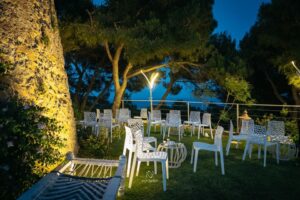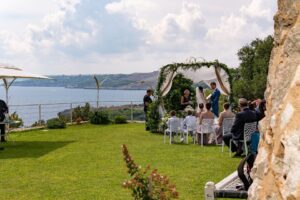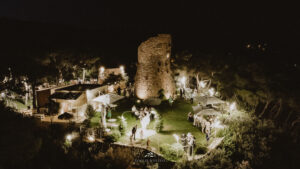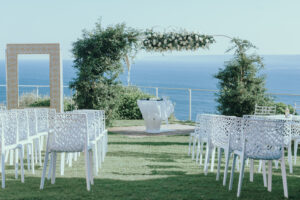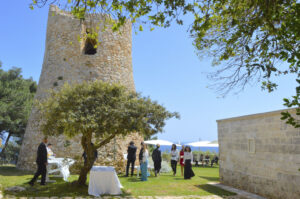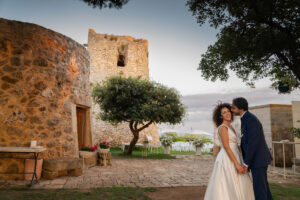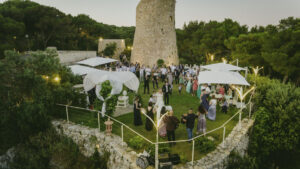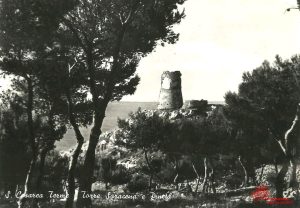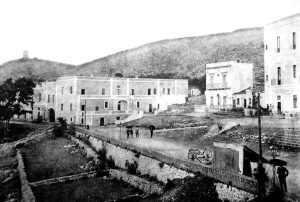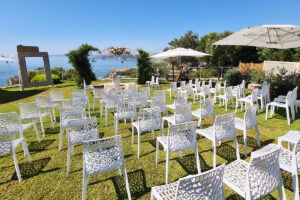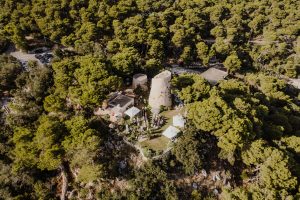“it stands like a firm tower; whose top never collapses due to the blowing of winds”
Dante Alighieri, Canto V of Purgatory
The Saracen tower, unique and spectacular stands out on a blue sea surrounded by the embrace of the pine forest, where spouses and guests, with a single glance can admire a boundless horizon that goes from the Leuca Cape to the Balcans.
Immersed in the vegetation of a large pine forest and positioned on a rocky ridge above the town of Santa Cesarea Terme, it rises, the superb and homonymous tower also called Torre di Monte Saracino, the patient guardian of incursions and storms. If only the tower could speak it would tell us a story destined to repeat itself, assaults from people coming from faraway lands, stories of encounters and crashes destined to change for ever the calm and ordered everyday life. Actually we do not know exactly when it was built but we find it mentioned in the cartography of 1500. The location on the high coast and the small and circular plan put it in relation with the other sister towers, south of Otranto, built with haste after the massacre at the hands of the Turks of the population of Otranto. Indeed, the building of watch towers in Apulia it’s a Norman practice and it dates back to the XI century but in the course of various centuries the structures changed shape and goals.
The walls, built from stones with irregular shapes kept together by mortar and lime with fragments of calcareous sand and shattered clay tiles, resist the weight of history and bring in themselves traces of far away echoes. At the south and not far from the tower a building made of carparo stone ashlars rises. The entrance faces the short southern side and the intern with barrel vaults seems to be built with collapse materials. Embedded in the walls there still are the ashlars shaped and perforated for tying horses. The secondo building made with dry masonry and of non-developed dimensions was built after the Santa Cesarea Tower was declared no more suitable to the control tasks of the sea area in front of it. Another building made with dry masonry is near the previously described buildings: it is a “caseddha” used by farmers as a recovery from bad weather during the fishing season. The recovery interventions allowed the safeguard of the Tower and of the two buildings nearby, that, together, have restored the old architectural complex, a very relevant testimony for the history of the strip of Salento territory.
You cannot think of Cala dei Balcani without its Tower, visiting it or just being near it takes us back to breathe the smell of a time gone by and which forcefully retains its magic.
The ancient Torre di Monte Saracino was probably built during the Aragon who between ‘400 and ‘500 carried out an important phase of territorial rearmament with the consequent defensive reconfiguration of the territory. So the towers due to the introduction of gunpowder became shorter, as the topping became necessary, they took a cylindrical shape with a presence of casemate towers and escarpment walls. It was a general belief that the Otranto Land was the extreme defensive bulwark against the Turks, and from this came the fear that the Realm of Naples could badly embank and prevent the pirates incursions. After the sack of Otrant of August 14, 1480 the Spanish crown put particular care in the reorganization of of the defensive structure of the Southern Lands of the Realm providing the coast of armed towers, fortifications and strongholds.
In this precise historical momento the costruction of the Santa Cesarea Terme tower or Saracen Mountain Tower has to be put. It rises to a truncated cone shape with a 9 meters diameter circular base and an height of 10 meters and it has the signs of the modifications that partially affected it in its original configuration.


